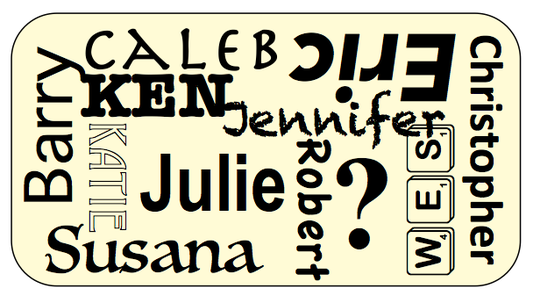|
(This is a migration and updated post - it was first shared at the FUNdoing.com Blog. We are moving theoretical posts to OnTeamBuidling in an effort to organize content.)
This post was inspired by Katie, a team builder, adventure educator and FUN Follower. Her situation is a common tale - she wanted something different. (An aside - I'd love to study what motivates team builders to want something different. I know some that don't - and it works for them.)
In an email Katie told me: My favorite name game is Group Juggle because it seems to be the most helpful in actually learning names. But, after you facilitate it for the hundredth time it's time for something different. Then she asked, Do you know of any [other name games] that are as helpful and active as Group Juggle that work with youth and adults? In my response to Katie (along with some suggested Name Games), I said that I know "Name Games" in two ways:
I also told Katie that if the facilitator actually takes the time after an activity (like Group Juggle) to go around and ask for volunteers to call out as many names as they can, then we're practicing and learning names (and offering a "challenge" as well - Who will take the risk at making a mistake?). A win-win learning opp in my book. (But, in my experience, I don't see this happening very much by team builders who use name games - it might not be necessary, or it simply might not seem important enough. Learning names important enough - don't get me started.) If I'm playing a 'name game' with my group, it is always for the facilitated objective of learning and practicing names. The goal is to learn names, any other outcome is secondary (and certainly a good way to get some 'mileage' out of an experience). Below is my all-time favorite way to use a Name Game for learning and practicing names in a fun and purposefully stressful (educationally speaking) way.
Toss-a-Name Game & Testing Out Toss-a-Name Game comes from the first edition of Silver Bullets (Rohnke, 1984). For a circle of about 24 participants, you need a bunch a safe tossable objects (safe enough to hit the cranial regions without damage - not that we're doing this on purpose, but there is a possibility of cranial contact!). I show up with at least one tossable for every two people.
One object starts the action. The person tossing the object (anyone can be chosen to start the first object) is asked to:
The next person to possess this first object (since the intended person might not get the toss), follows the same PTP - name, connection, THEN toss. This one object goes around the group, without stopping, in any which-way - no 'pattern' is required (like in Group Juggle). Once the PTP process is understood, after a minute or so, I will then stop the action and tell my group about Testing Out. Here's a possible script: Now that you understand how PTP works, I would like to give you a challenge - remember, it's your challenge, it's your choice, so it's up to you if you want to try "testing out." We're going to continue the activity, following PTP. After a few minutes I will stop the process and ask who would like to test out on Names. If you are up for the challenge, the first thing you will need to tell me is what grade you want to go for - this means, getting 90% or more names correct gives you an "A" grade. (For an A+ you need to get all the names correct.) A "B" is in the 80th percents, a "C" is in the 70th percents, and so on. If you don't get the grade you want, you can try again after another round of tossing play. "Testing out" on names has proven to be a successful challenge for my groups. Even though there is no real grade given (nothing is written down), going for the "grade" seems to influence the learning process and (self-) motivates (most) participants to practicing names as they toss objects around the group (and noticing other names when they are not tossing). If a person doesn't know someone's name they can ask for help, "Hey, you in the red shirt, please help me out. What is your name?" Once a name is given, then it's practice time - name, connection, THEN toss. Increasing the Challenge Level Now, something else starts happening in Toss-a-Name Game. While PTP is going on, more objects are added to the process when the facilitator feels the group can handle more - I add one new object every minute of so. All the tossing about creates some distractions, anxiety and fun (now you get the cranial reference) while the potential learning is going on. Okay (don't forget), after every couple of minutes, stop the action and ask if anyone wants to test out. In the beginning, I might simply ask, Who thinks they have 50% of the names? Maybe 70%? How about 80%? (You get to see if there is some learning going on and if someone may have the confidence to try and test out - those 90 percenters.) Okay, who's willing to try the test? I'll take two or three volunteers. I ask for the grade they want then let them have at it. We all celebrate every person's attempt, whether it was a success in their eyes or not - because they can try again another time. One of the secondary facilitated objectives of this activity experience is to show the group how you are all creating a safe learning environment - if you take a "risk" we will support you. With that said, I am always one of the first to "test," and I usually have to try a few times before I get my A+. (I show my group I'm willing to take the risk as well - and willing to "fail" and learn from the process.) Now, you might be thinking, Testing is the outcome Chris! I thought you said learning names was the outcome? Again, I see testing as the motivator - something of choice is on the line. Each person chooses her/his own grade (goal) if s/he even wants to test out, does their best and celebrates the attempt knowing they gave it a shot (took a risk in a safe environment). This is setting the stage for (leading into) the kinds of activities and experiences coming up in the program. There will be some risk involved, but if the group can practice supporting each other during their risk-taking, they will find success - in the many ways they define it. All this, you can do with a Name Game. Katie, thanks for letting me share your question. If any of you out there want to share your favorite Name Game, leave us (Katie and me) a comment below. Thanks! Have FUN out there! Chris Cavert, Ed.D. P.S. For me, my most practiced way of learning my students/participants names is to have them create Name Cards (like the ones we use for, Name Card Return that uses names). I'm practicing during the activity, then after I continue to shuffle through the Name Cards as they are working in order to practice and remember. I can usually know, and remember everyone's name (I'm good with this process up to about 30 people) within an hour.
Would you like a (super) quick email notification when new OTB content (blog post or podcast episode) is available? Fill out the form below and we'll let you know.
0 Comments
|
OnTeamBuilding is a forum for like-minded people to share ideas and experiences related to team building. FREE Team Building
Activity Resources OTB FacilitatorDr. Chris Cavert is an educator, author and trainer. His passion is helping team builders learn and grow. Archives
January 2024
|



 RSS Feed
RSS Feed